COIT20253: Big Data's Impact on the Publishing Industry - Analysis
VerifiedAdded on 2021/04/23
|11
|2374
|73
Report
AI Summary
This report examines the application of Big Data solutions within the publishing industry, focusing on its definition, impact, and practical examples. It explores how companies like Kobo Inc. leverage Big Data for business intelligence, analyzing reader behavior, online versus offline data, and selection strategies for Big Data applications. The report delves into the outcomes, technologies, and business impacts of Big Data solutions, including both positive and negative aspects such as privacy concerns. Furthermore, it discusses the organizational changes and impacts associated with implementing Big Data, concluding that Big Data is essential for the publishing industry, enabling better content delivery, marketing strategies, and overall business success, but also acknowledges the need for careful consideration of privacy and ethical implications. The report provides references to support the analysis.
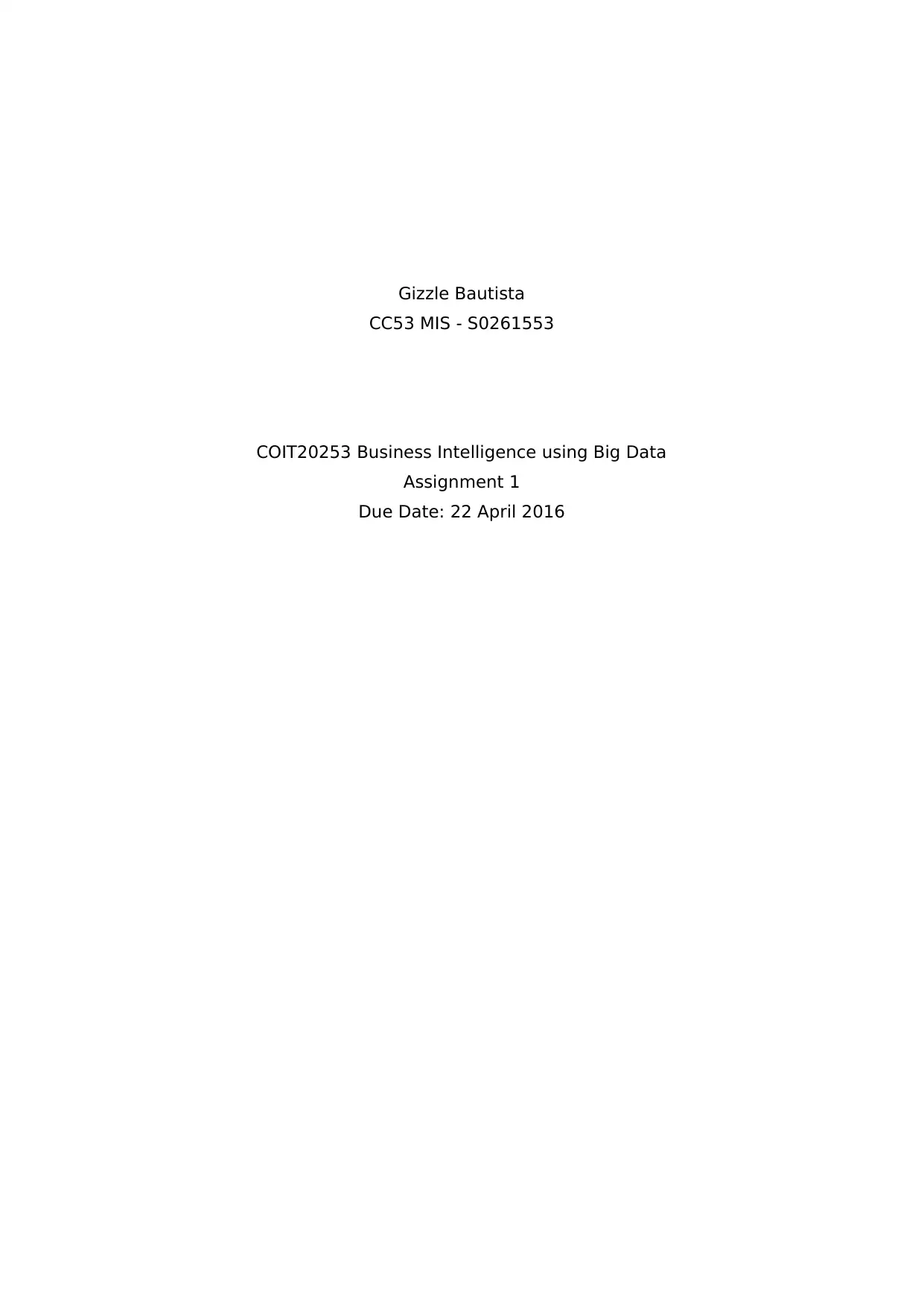
Gizzle Bautista
CC53 MIS - S0261553
COIT20253 Business Intelligence using Big Data
Assignment 1
Due Date: 22 April 2016
CC53 MIS - S0261553
COIT20253 Business Intelligence using Big Data
Assignment 1
Due Date: 22 April 2016
Paraphrase This Document
Need a fresh take? Get an instant paraphrase of this document with our AI Paraphraser
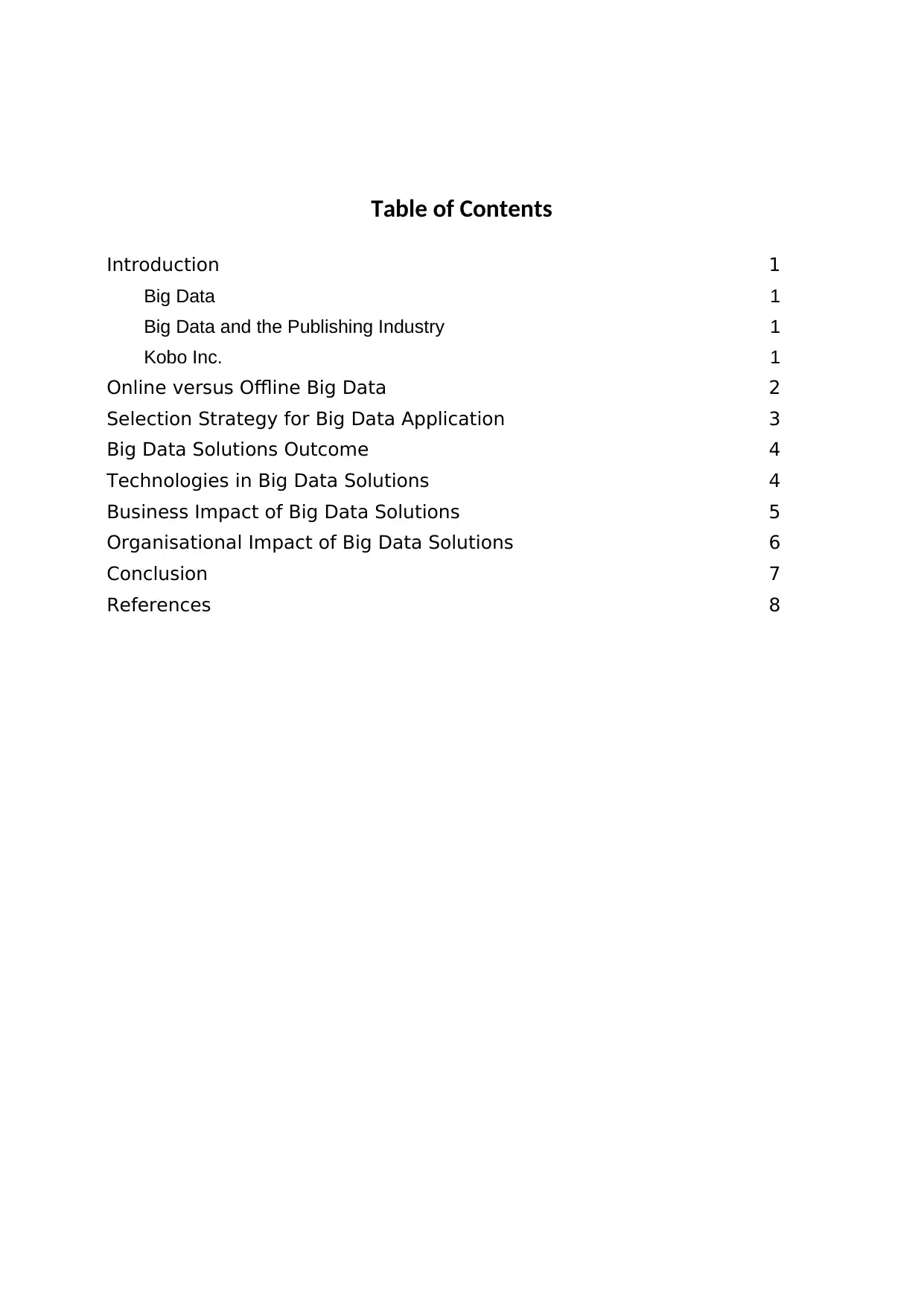
Table of Contents
Introduction 1
Big Data 1
Big Data and the Publishing Industry 1
Kobo Inc. 1
Online versus Offline Big Data 2
Selection Strategy for Big Data Application 3
Big Data Solutions Outcome 4
Technologies in Big Data Solutions 4
Business Impact of Big Data Solutions 5
Organisational Impact of Big Data Solutions 6
Conclusion 7
References 8
Introduction 1
Big Data 1
Big Data and the Publishing Industry 1
Kobo Inc. 1
Online versus Offline Big Data 2
Selection Strategy for Big Data Application 3
Big Data Solutions Outcome 4
Technologies in Big Data Solutions 4
Business Impact of Big Data Solutions 5
Organisational Impact of Big Data Solutions 6
Conclusion 7
References 8
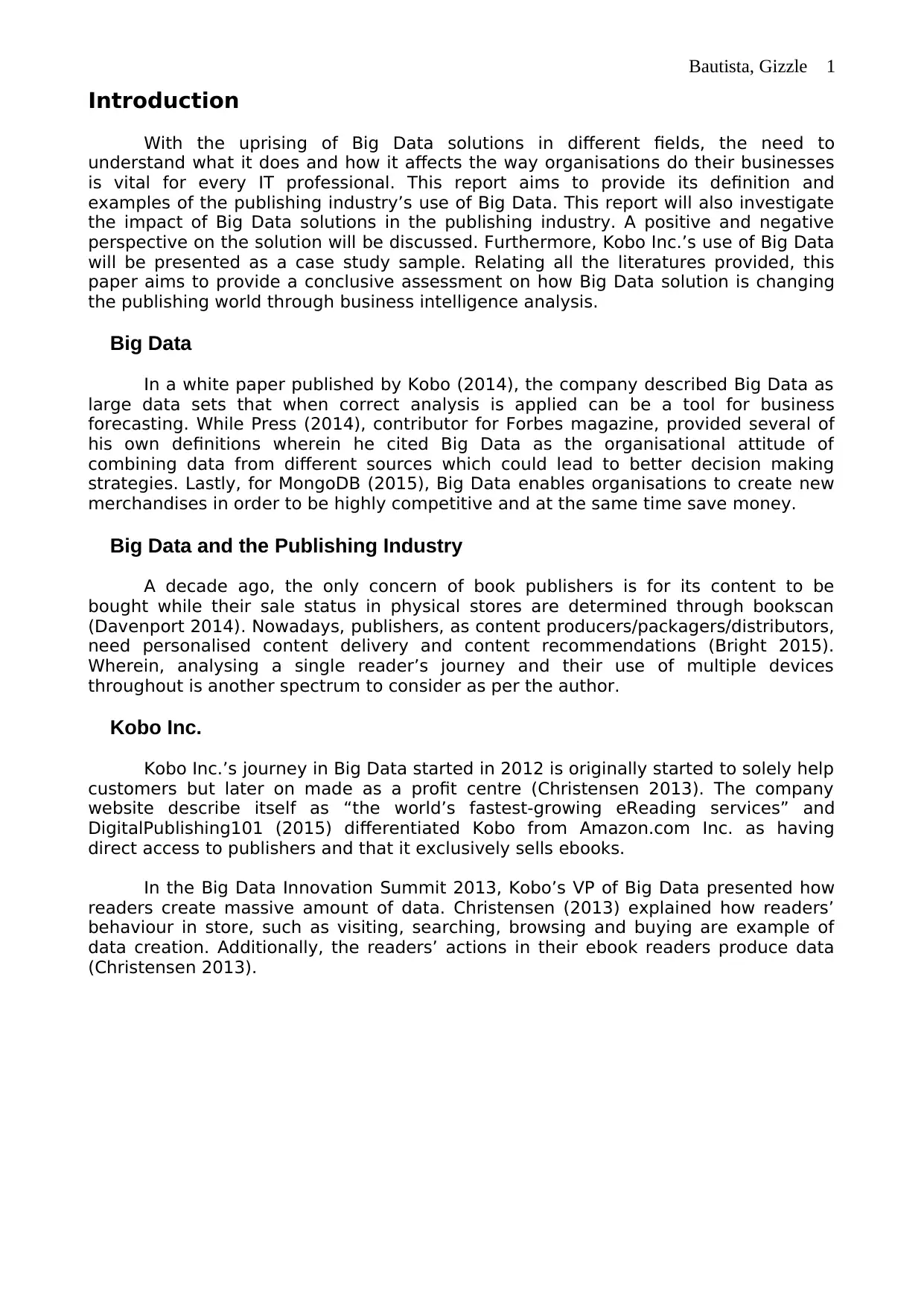
Bautista, Gizzle
Introduction
With the uprising of Big Data solutions in different fields, the need to
understand what it does and how it affects the way organisations do their businesses
is vital for every IT professional. This report aims to provide its definition and
examples of the publishing industry’s use of Big Data. This report will also investigate
the impact of Big Data solutions in the publishing industry. A positive and negative
perspective on the solution will be discussed. Furthermore, Kobo Inc.’s use of Big Data
will be presented as a case study sample. Relating all the literatures provided, this
paper aims to provide a conclusive assessment on how Big Data solution is changing
the publishing world through business intelligence analysis.
Big Data
In a white paper published by Kobo (2014), the company described Big Data as
large data sets that when correct analysis is applied can be a tool for business
forecasting. While Press (2014), contributor for Forbes magazine, provided several of
his own definitions wherein he cited Big Data as the organisational attitude of
combining data from different sources which could lead to better decision making
strategies. Lastly, for MongoDB (2015), Big Data enables organisations to create new
merchandises in order to be highly competitive and at the same time save money.
Big Data and the Publishing Industry
A decade ago, the only concern of book publishers is for its content to be
bought while their sale status in physical stores are determined through bookscan
(Davenport 2014). Nowadays, publishers, as content producers/packagers/distributors,
need personalised content delivery and content recommendations (Bright 2015).
Wherein, analysing a single reader’s journey and their use of multiple devices
throughout is another spectrum to consider as per the author.
Kobo Inc.
Kobo Inc.’s journey in Big Data started in 2012 is originally started to solely help
customers but later on made as a profit centre (Christensen 2013). The company
website describe itself as “the world’s fastest-growing eReading services” and
DigitalPublishing101 (2015) differentiated Kobo from Amazon.com Inc. as having
direct access to publishers and that it exclusively sells ebooks.
In the Big Data Innovation Summit 2013, Kobo’s VP of Big Data presented how
readers create massive amount of data. Christensen (2013) explained how readers’
behaviour in store, such as visiting, searching, browsing and buying are example of
data creation. Additionally, the readers’ actions in their ebook readers produce data
(Christensen 2013).
1
Introduction
With the uprising of Big Data solutions in different fields, the need to
understand what it does and how it affects the way organisations do their businesses
is vital for every IT professional. This report aims to provide its definition and
examples of the publishing industry’s use of Big Data. This report will also investigate
the impact of Big Data solutions in the publishing industry. A positive and negative
perspective on the solution will be discussed. Furthermore, Kobo Inc.’s use of Big Data
will be presented as a case study sample. Relating all the literatures provided, this
paper aims to provide a conclusive assessment on how Big Data solution is changing
the publishing world through business intelligence analysis.
Big Data
In a white paper published by Kobo (2014), the company described Big Data as
large data sets that when correct analysis is applied can be a tool for business
forecasting. While Press (2014), contributor for Forbes magazine, provided several of
his own definitions wherein he cited Big Data as the organisational attitude of
combining data from different sources which could lead to better decision making
strategies. Lastly, for MongoDB (2015), Big Data enables organisations to create new
merchandises in order to be highly competitive and at the same time save money.
Big Data and the Publishing Industry
A decade ago, the only concern of book publishers is for its content to be
bought while their sale status in physical stores are determined through bookscan
(Davenport 2014). Nowadays, publishers, as content producers/packagers/distributors,
need personalised content delivery and content recommendations (Bright 2015).
Wherein, analysing a single reader’s journey and their use of multiple devices
throughout is another spectrum to consider as per the author.
Kobo Inc.
Kobo Inc.’s journey in Big Data started in 2012 is originally started to solely help
customers but later on made as a profit centre (Christensen 2013). The company
website describe itself as “the world’s fastest-growing eReading services” and
DigitalPublishing101 (2015) differentiated Kobo from Amazon.com Inc. as having
direct access to publishers and that it exclusively sells ebooks.
In the Big Data Innovation Summit 2013, Kobo’s VP of Big Data presented how
readers create massive amount of data. Christensen (2013) explained how readers’
behaviour in store, such as visiting, searching, browsing and buying are example of
data creation. Additionally, the readers’ actions in their ebook readers produce data
(Christensen 2013).
1
⊘ This is a preview!⊘
Do you want full access?
Subscribe today to unlock all pages.

Trusted by 1+ million students worldwide
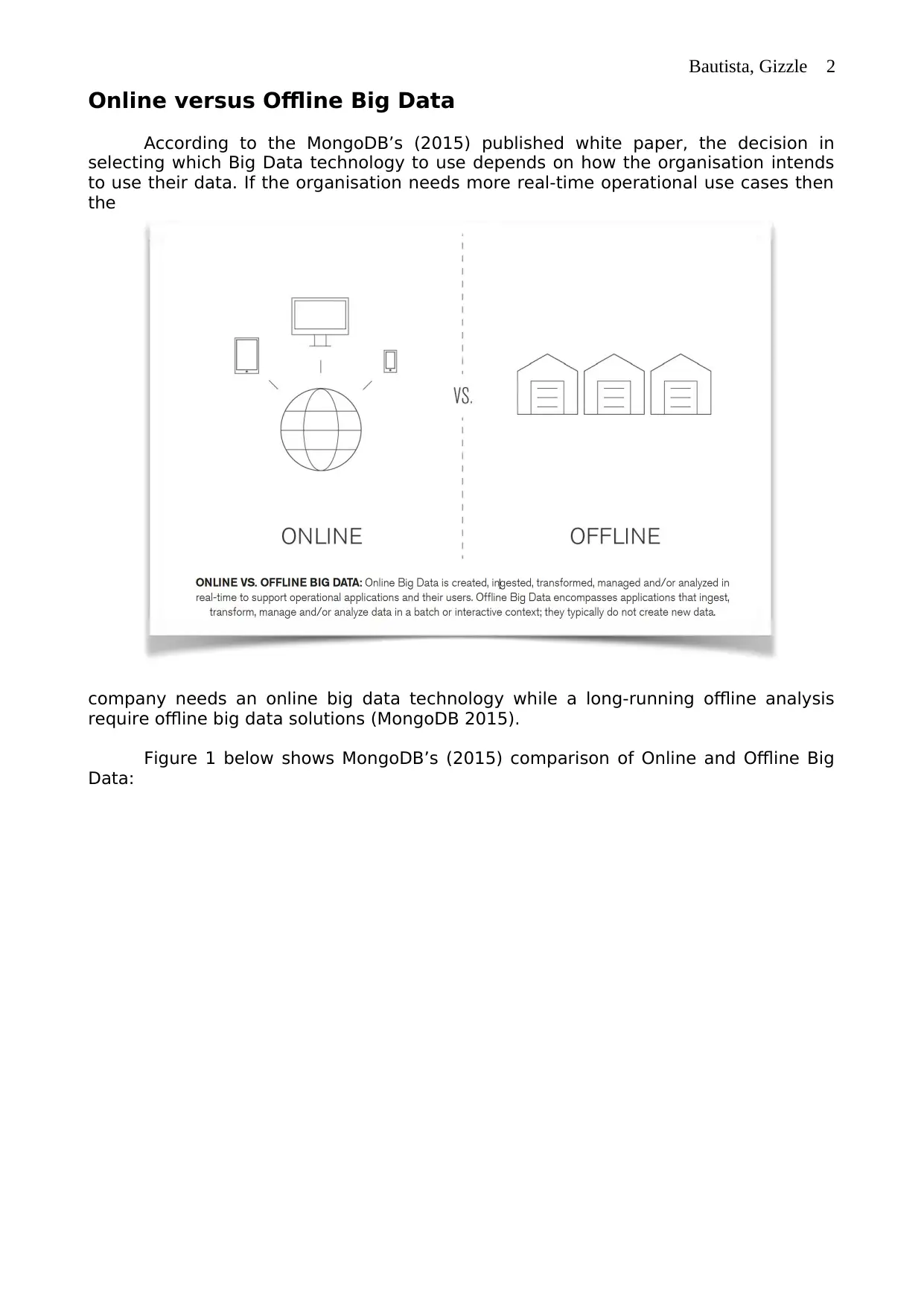
Bautista, Gizzle
Online versus Offline Big Data
According to the MongoDB’s (2015) published white paper, the decision in
selecting which Big Data technology to use depends on how the organisation intends
to use their data. If the organisation needs more real-time operational use cases then
the
company needs an online big data technology while a long-running offline analysis
require offline big data solutions (MongoDB 2015).
Figure 1 below shows MongoDB’s (2015) comparison of Online and Offline Big
Data:
2
Online versus Offline Big Data
According to the MongoDB’s (2015) published white paper, the decision in
selecting which Big Data technology to use depends on how the organisation intends
to use their data. If the organisation needs more real-time operational use cases then
the
company needs an online big data technology while a long-running offline analysis
require offline big data solutions (MongoDB 2015).
Figure 1 below shows MongoDB’s (2015) comparison of Online and Offline Big
Data:
2
Paraphrase This Document
Need a fresh take? Get an instant paraphrase of this document with our AI Paraphraser
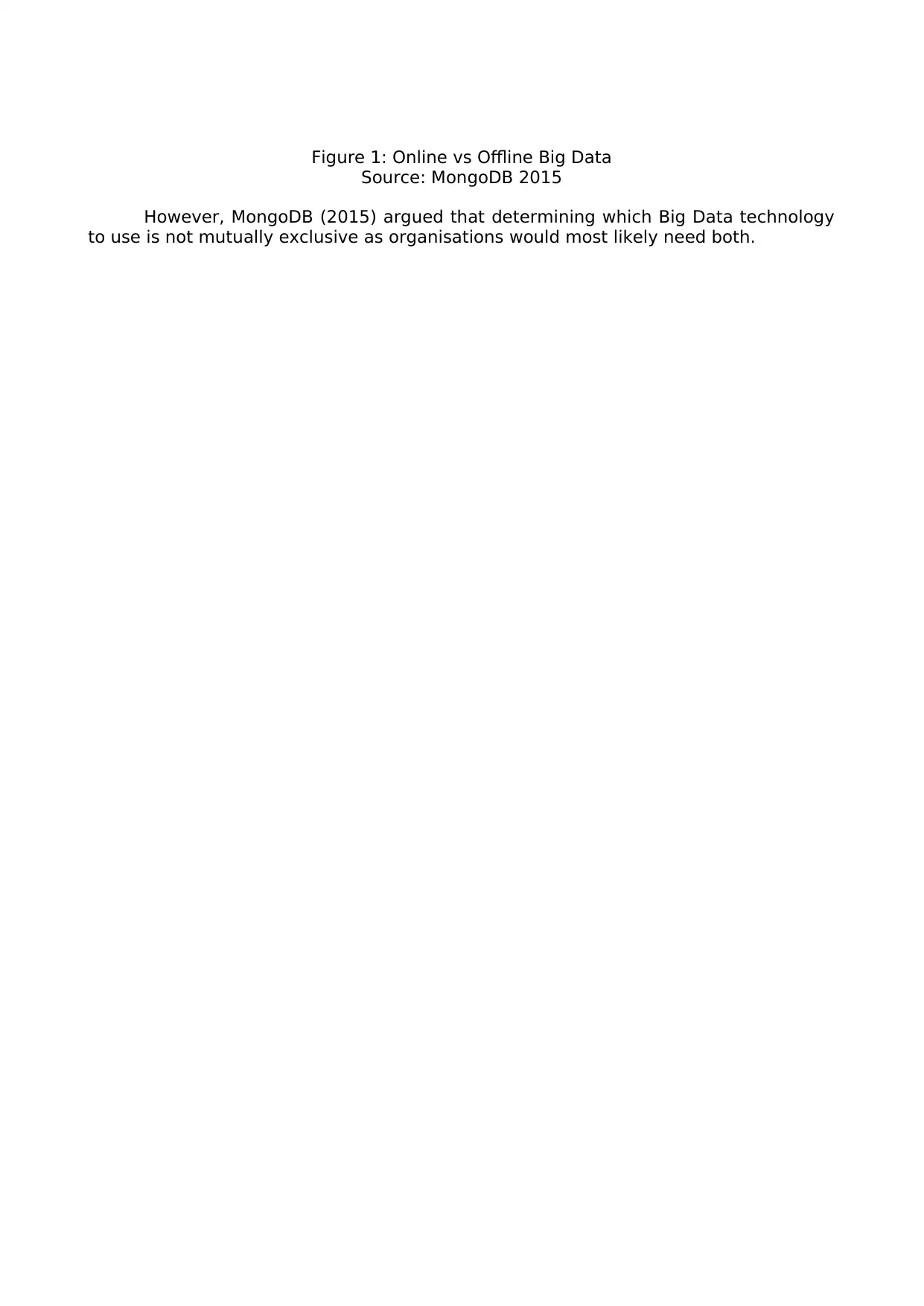
Figure 1: Online vs Offline Big Data
Source: MongoDB 2015
However, MongoDB (2015) argued that determining which Big Data technology
to use is not mutually exclusive as organisations would most likely need both.
Source: MongoDB 2015
However, MongoDB (2015) argued that determining which Big Data technology
to use is not mutually exclusive as organisations would most likely need both.
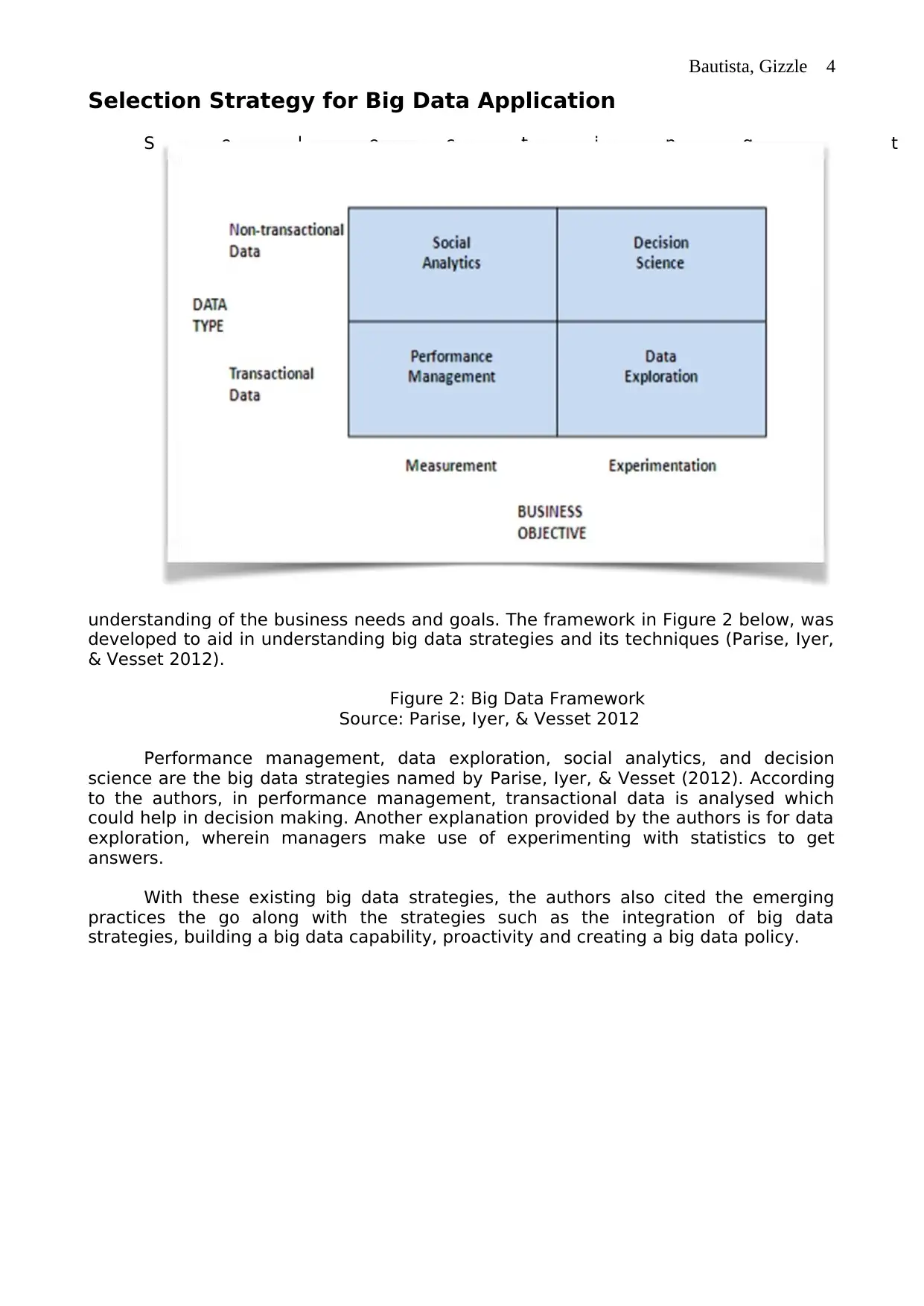
Bautista, Gizzle
Selection Strategy for Big Data Application
S e l e c t i n g t
understanding of the business needs and goals. The framework in Figure 2 below, was
developed to aid in understanding big data strategies and its techniques (Parise, Iyer,
& Vesset 2012).
Figure 2: Big Data Framework
Source: Parise, Iyer, & Vesset 2012
Performance management, data exploration, social analytics, and decision
science are the big data strategies named by Parise, Iyer, & Vesset (2012). According
to the authors, in performance management, transactional data is analysed which
could help in decision making. Another explanation provided by the authors is for data
exploration, wherein managers make use of experimenting with statistics to get
answers.
With these existing big data strategies, the authors also cited the emerging
practices the go along with the strategies such as the integration of big data
strategies, building a big data capability, proactivity and creating a big data policy.
4
Selection Strategy for Big Data Application
S e l e c t i n g t
understanding of the business needs and goals. The framework in Figure 2 below, was
developed to aid in understanding big data strategies and its techniques (Parise, Iyer,
& Vesset 2012).
Figure 2: Big Data Framework
Source: Parise, Iyer, & Vesset 2012
Performance management, data exploration, social analytics, and decision
science are the big data strategies named by Parise, Iyer, & Vesset (2012). According
to the authors, in performance management, transactional data is analysed which
could help in decision making. Another explanation provided by the authors is for data
exploration, wherein managers make use of experimenting with statistics to get
answers.
With these existing big data strategies, the authors also cited the emerging
practices the go along with the strategies such as the integration of big data
strategies, building a big data capability, proactivity and creating a big data policy.
4
⊘ This is a preview!⊘
Do you want full access?
Subscribe today to unlock all pages.

Trusted by 1+ million students worldwide
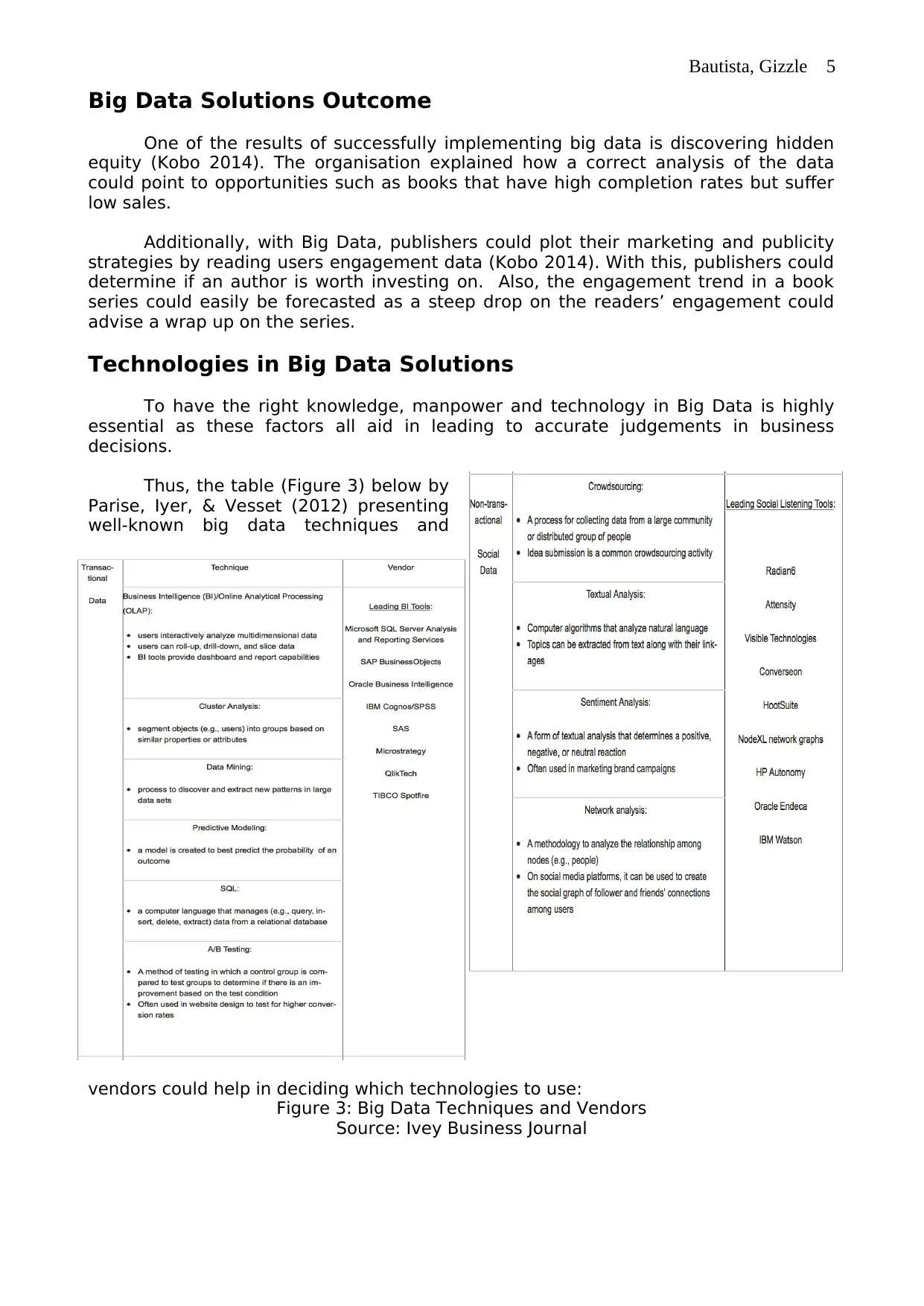
Bautista, Gizzle
Big Data Solutions Outcome
One of the results of successfully implementing big data is discovering hidden
equity (Kobo 2014). The organisation explained how a correct analysis of the data
could point to opportunities such as books that have high completion rates but suffer
low sales.
Additionally, with Big Data, publishers could plot their marketing and publicity
strategies by reading users engagement data (Kobo 2014). With this, publishers could
determine if an author is worth investing on. Also, the engagement trend in a book
series could easily be forecasted as a steep drop on the readers’ engagement could
advise a wrap up on the series.
Technologies in Big Data Solutions
To have the right knowledge, manpower and technology in Big Data is highly
essential as these factors all aid in leading to accurate judgements in business
decisions.
Thus, the table (Figure 3) below by
Parise, Iyer, & Vesset (2012) presenting
well-known big data techniques and
vendors could help in deciding which technologies to use:
Figure 3: Big Data Techniques and Vendors
Source: Ivey Business Journal
5
Big Data Solutions Outcome
One of the results of successfully implementing big data is discovering hidden
equity (Kobo 2014). The organisation explained how a correct analysis of the data
could point to opportunities such as books that have high completion rates but suffer
low sales.
Additionally, with Big Data, publishers could plot their marketing and publicity
strategies by reading users engagement data (Kobo 2014). With this, publishers could
determine if an author is worth investing on. Also, the engagement trend in a book
series could easily be forecasted as a steep drop on the readers’ engagement could
advise a wrap up on the series.
Technologies in Big Data Solutions
To have the right knowledge, manpower and technology in Big Data is highly
essential as these factors all aid in leading to accurate judgements in business
decisions.
Thus, the table (Figure 3) below by
Parise, Iyer, & Vesset (2012) presenting
well-known big data techniques and
vendors could help in deciding which technologies to use:
Figure 3: Big Data Techniques and Vendors
Source: Ivey Business Journal
5
Paraphrase This Document
Need a fresh take? Get an instant paraphrase of this document with our AI Paraphraser
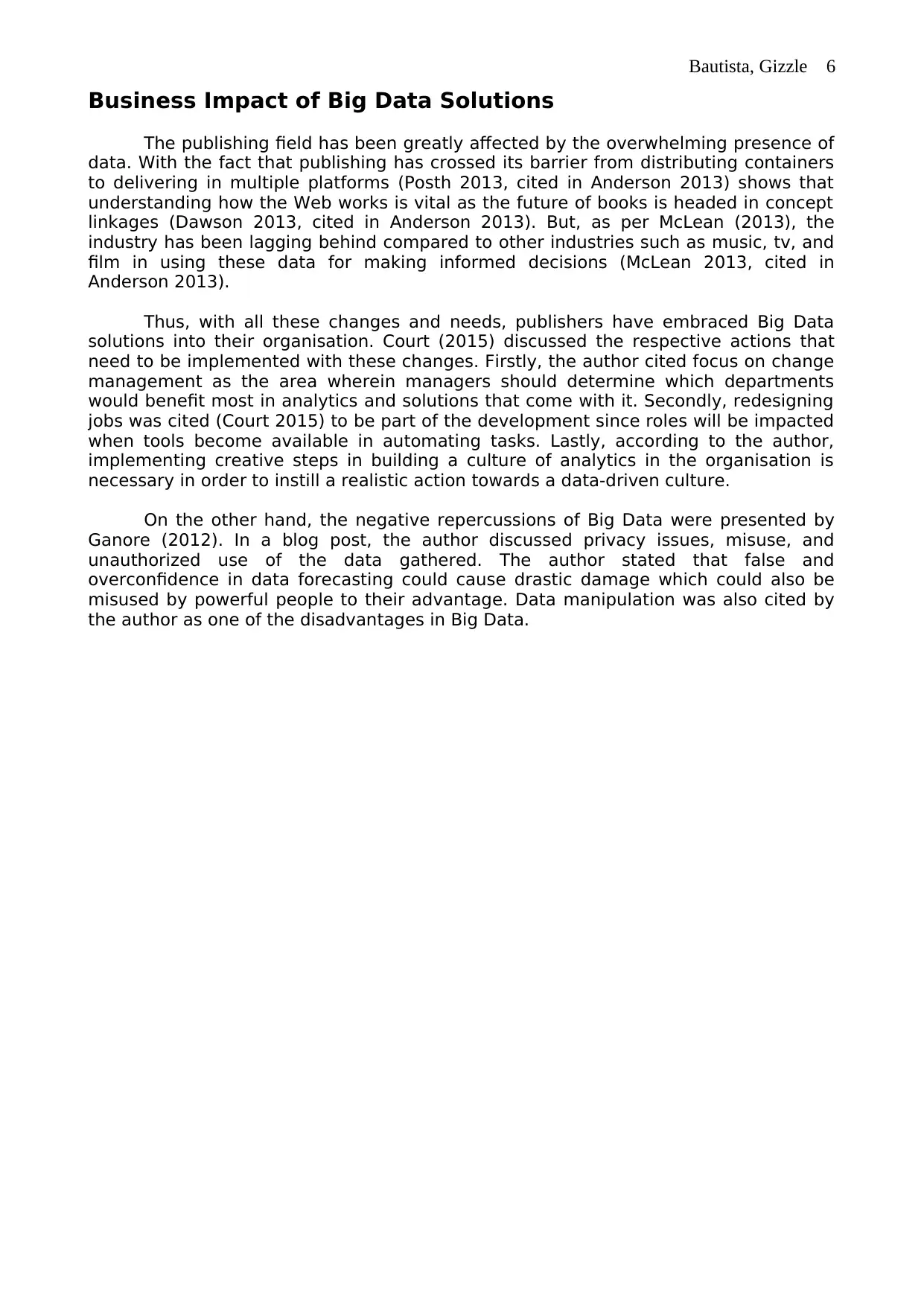
Bautista, Gizzle
Business Impact of Big Data Solutions
The publishing field has been greatly affected by the overwhelming presence of
data. With the fact that publishing has crossed its barrier from distributing containers
to delivering in multiple platforms (Posth 2013, cited in Anderson 2013) shows that
understanding how the Web works is vital as the future of books is headed in concept
linkages (Dawson 2013, cited in Anderson 2013). But, as per McLean (2013), the
industry has been lagging behind compared to other industries such as music, tv, and
film in using these data for making informed decisions (McLean 2013, cited in
Anderson 2013).
Thus, with all these changes and needs, publishers have embraced Big Data
solutions into their organisation. Court (2015) discussed the respective actions that
need to be implemented with these changes. Firstly, the author cited focus on change
management as the area wherein managers should determine which departments
would benefit most in analytics and solutions that come with it. Secondly, redesigning
jobs was cited (Court 2015) to be part of the development since roles will be impacted
when tools become available in automating tasks. Lastly, according to the author,
implementing creative steps in building a culture of analytics in the organisation is
necessary in order to instill a realistic action towards a data-driven culture.
On the other hand, the negative repercussions of Big Data were presented by
Ganore (2012). In a blog post, the author discussed privacy issues, misuse, and
unauthorized use of the data gathered. The author stated that false and
overconfidence in data forecasting could cause drastic damage which could also be
misused by powerful people to their advantage. Data manipulation was also cited by
the author as one of the disadvantages in Big Data.
6
Business Impact of Big Data Solutions
The publishing field has been greatly affected by the overwhelming presence of
data. With the fact that publishing has crossed its barrier from distributing containers
to delivering in multiple platforms (Posth 2013, cited in Anderson 2013) shows that
understanding how the Web works is vital as the future of books is headed in concept
linkages (Dawson 2013, cited in Anderson 2013). But, as per McLean (2013), the
industry has been lagging behind compared to other industries such as music, tv, and
film in using these data for making informed decisions (McLean 2013, cited in
Anderson 2013).
Thus, with all these changes and needs, publishers have embraced Big Data
solutions into their organisation. Court (2015) discussed the respective actions that
need to be implemented with these changes. Firstly, the author cited focus on change
management as the area wherein managers should determine which departments
would benefit most in analytics and solutions that come with it. Secondly, redesigning
jobs was cited (Court 2015) to be part of the development since roles will be impacted
when tools become available in automating tasks. Lastly, according to the author,
implementing creative steps in building a culture of analytics in the organisation is
necessary in order to instill a realistic action towards a data-driven culture.
On the other hand, the negative repercussions of Big Data were presented by
Ganore (2012). In a blog post, the author discussed privacy issues, misuse, and
unauthorized use of the data gathered. The author stated that false and
overconfidence in data forecasting could cause drastic damage which could also be
misused by powerful people to their advantage. Data manipulation was also cited by
the author as one of the disadvantages in Big Data.
6
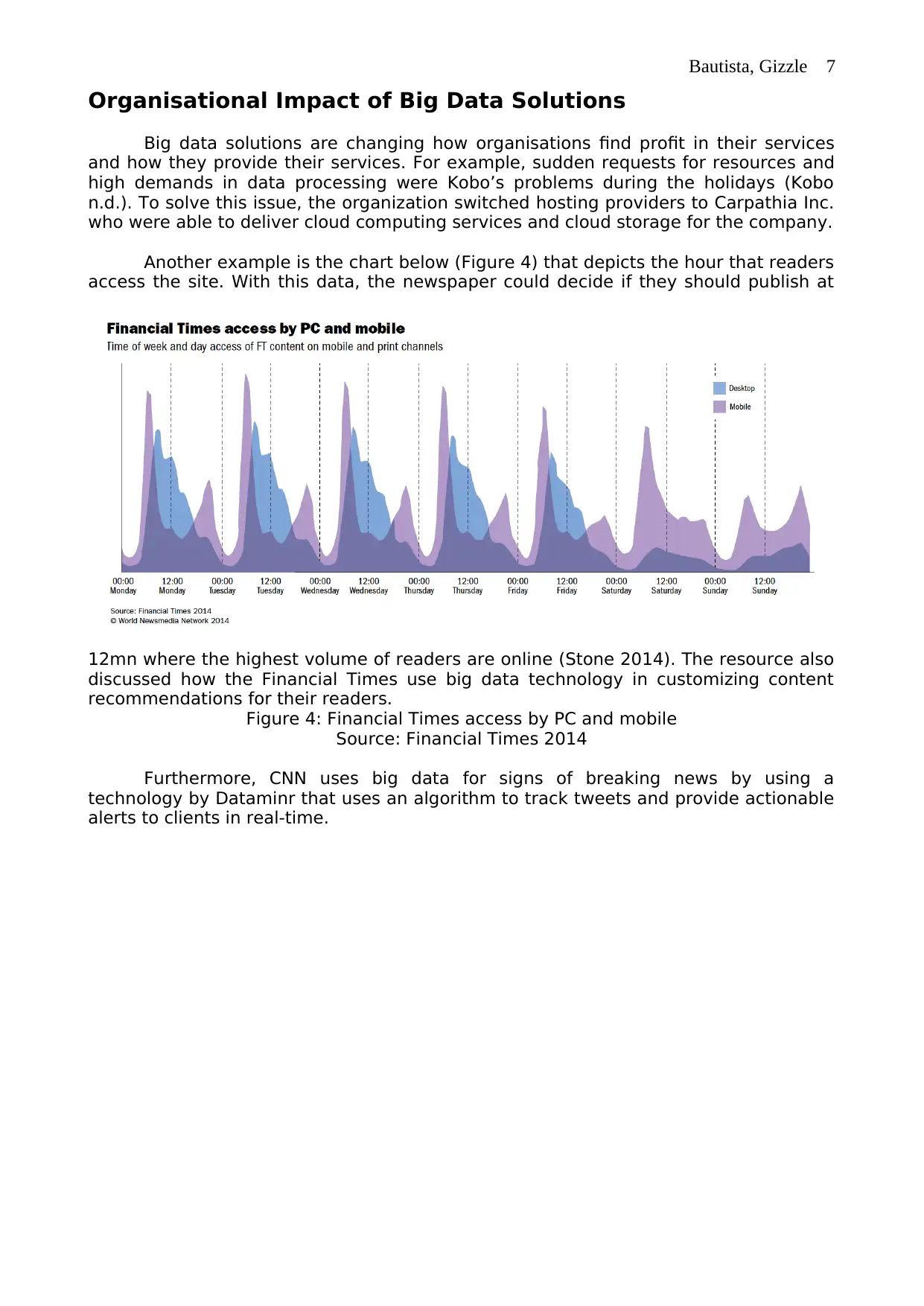
Bautista, Gizzle
Organisational Impact of Big Data Solutions
Big data solutions are changing how organisations find profit in their services
and how they provide their services. For example, sudden requests for resources and
high demands in data processing were Kobo’s problems during the holidays (Kobo
n.d.). To solve this issue, the organization switched hosting providers to Carpathia Inc.
who were able to deliver cloud computing services and cloud storage for the company.
Another example is the chart below (Figure 4) that depicts the hour that readers
access the site. With this data, the newspaper could decide if they should publish at
12mn where the highest volume of readers are online (Stone 2014). The resource also
discussed how the Financial Times use big data technology in customizing content
recommendations for their readers.
Figure 4: Financial Times access by PC and mobile
Source: Financial Times 2014
Furthermore, CNN uses big data for signs of breaking news by using a
technology by Dataminr that uses an algorithm to track tweets and provide actionable
alerts to clients in real-time.
7
Organisational Impact of Big Data Solutions
Big data solutions are changing how organisations find profit in their services
and how they provide their services. For example, sudden requests for resources and
high demands in data processing were Kobo’s problems during the holidays (Kobo
n.d.). To solve this issue, the organization switched hosting providers to Carpathia Inc.
who were able to deliver cloud computing services and cloud storage for the company.
Another example is the chart below (Figure 4) that depicts the hour that readers
access the site. With this data, the newspaper could decide if they should publish at
12mn where the highest volume of readers are online (Stone 2014). The resource also
discussed how the Financial Times use big data technology in customizing content
recommendations for their readers.
Figure 4: Financial Times access by PC and mobile
Source: Financial Times 2014
Furthermore, CNN uses big data for signs of breaking news by using a
technology by Dataminr that uses an algorithm to track tweets and provide actionable
alerts to clients in real-time.
7
⊘ This is a preview!⊘
Do you want full access?
Subscribe today to unlock all pages.

Trusted by 1+ million students worldwide
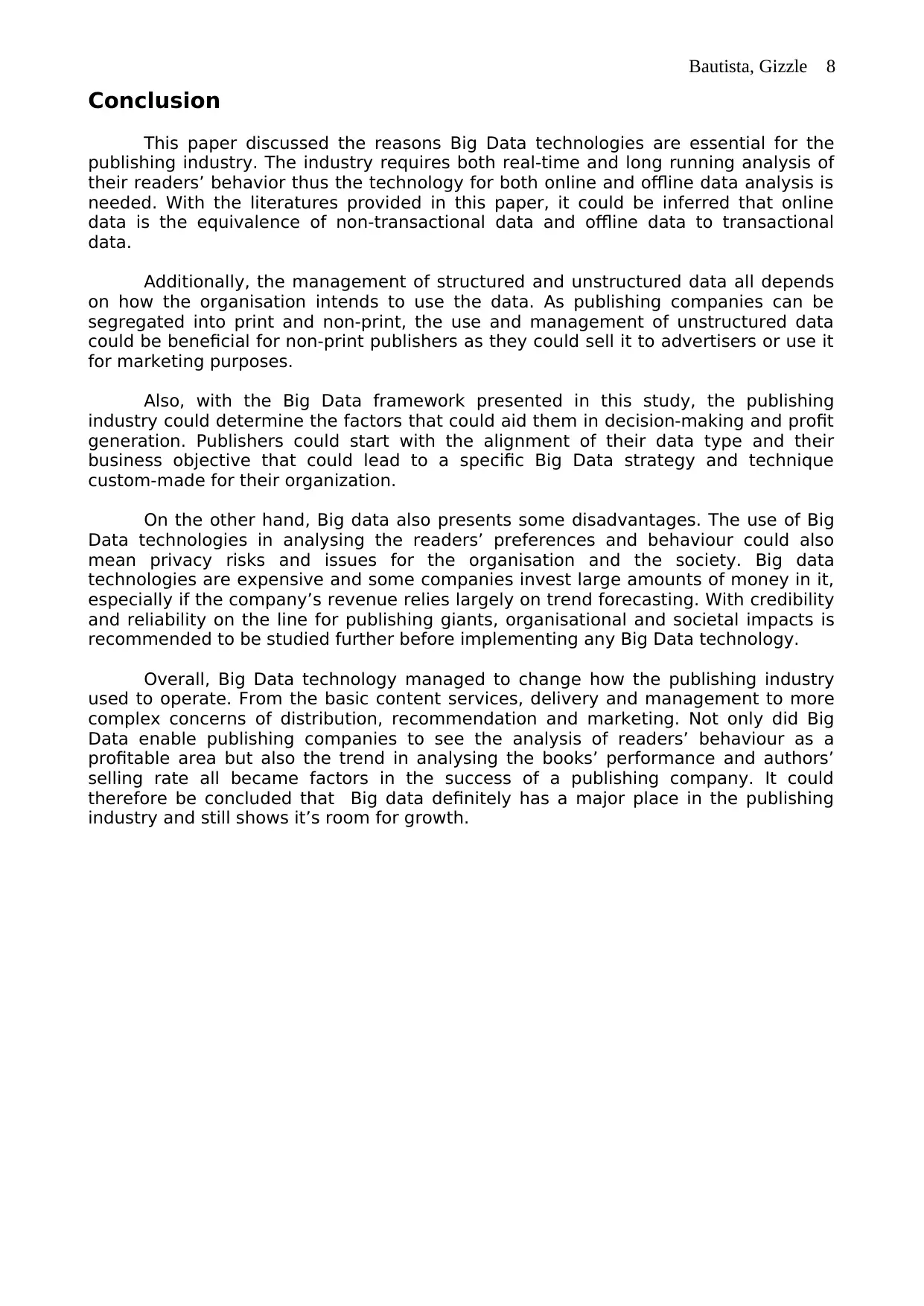
Bautista, Gizzle
Conclusion
This paper discussed the reasons Big Data technologies are essential for the
publishing industry. The industry requires both real-time and long running analysis of
their readers’ behavior thus the technology for both online and offline data analysis is
needed. With the literatures provided in this paper, it could be inferred that online
data is the equivalence of non-transactional data and offline data to transactional
data.
Additionally, the management of structured and unstructured data all depends
on how the organisation intends to use the data. As publishing companies can be
segregated into print and non-print, the use and management of unstructured data
could be beneficial for non-print publishers as they could sell it to advertisers or use it
for marketing purposes.
Also, with the Big Data framework presented in this study, the publishing
industry could determine the factors that could aid them in decision-making and profit
generation. Publishers could start with the alignment of their data type and their
business objective that could lead to a specific Big Data strategy and technique
custom-made for their organization.
On the other hand, Big data also presents some disadvantages. The use of Big
Data technologies in analysing the readers’ preferences and behaviour could also
mean privacy risks and issues for the organisation and the society. Big data
technologies are expensive and some companies invest large amounts of money in it,
especially if the company’s revenue relies largely on trend forecasting. With credibility
and reliability on the line for publishing giants, organisational and societal impacts is
recommended to be studied further before implementing any Big Data technology.
Overall, Big Data technology managed to change how the publishing industry
used to operate. From the basic content services, delivery and management to more
complex concerns of distribution, recommendation and marketing. Not only did Big
Data enable publishing companies to see the analysis of readers’ behaviour as a
profitable area but also the trend in analysing the books’ performance and authors’
selling rate all became factors in the success of a publishing company. It could
therefore be concluded that Big data definitely has a major place in the publishing
industry and still shows it’s room for growth.
8
Conclusion
This paper discussed the reasons Big Data technologies are essential for the
publishing industry. The industry requires both real-time and long running analysis of
their readers’ behavior thus the technology for both online and offline data analysis is
needed. With the literatures provided in this paper, it could be inferred that online
data is the equivalence of non-transactional data and offline data to transactional
data.
Additionally, the management of structured and unstructured data all depends
on how the organisation intends to use the data. As publishing companies can be
segregated into print and non-print, the use and management of unstructured data
could be beneficial for non-print publishers as they could sell it to advertisers or use it
for marketing purposes.
Also, with the Big Data framework presented in this study, the publishing
industry could determine the factors that could aid them in decision-making and profit
generation. Publishers could start with the alignment of their data type and their
business objective that could lead to a specific Big Data strategy and technique
custom-made for their organization.
On the other hand, Big data also presents some disadvantages. The use of Big
Data technologies in analysing the readers’ preferences and behaviour could also
mean privacy risks and issues for the organisation and the society. Big data
technologies are expensive and some companies invest large amounts of money in it,
especially if the company’s revenue relies largely on trend forecasting. With credibility
and reliability on the line for publishing giants, organisational and societal impacts is
recommended to be studied further before implementing any Big Data technology.
Overall, Big Data technology managed to change how the publishing industry
used to operate. From the basic content services, delivery and management to more
complex concerns of distribution, recommendation and marketing. Not only did Big
Data enable publishing companies to see the analysis of readers’ behaviour as a
profitable area but also the trend in analysing the books’ performance and authors’
selling rate all became factors in the success of a publishing company. It could
therefore be concluded that Big data definitely has a major place in the publishing
industry and still shows it’s room for growth.
8
Paraphrase This Document
Need a fresh take? Get an instant paraphrase of this document with our AI Paraphraser
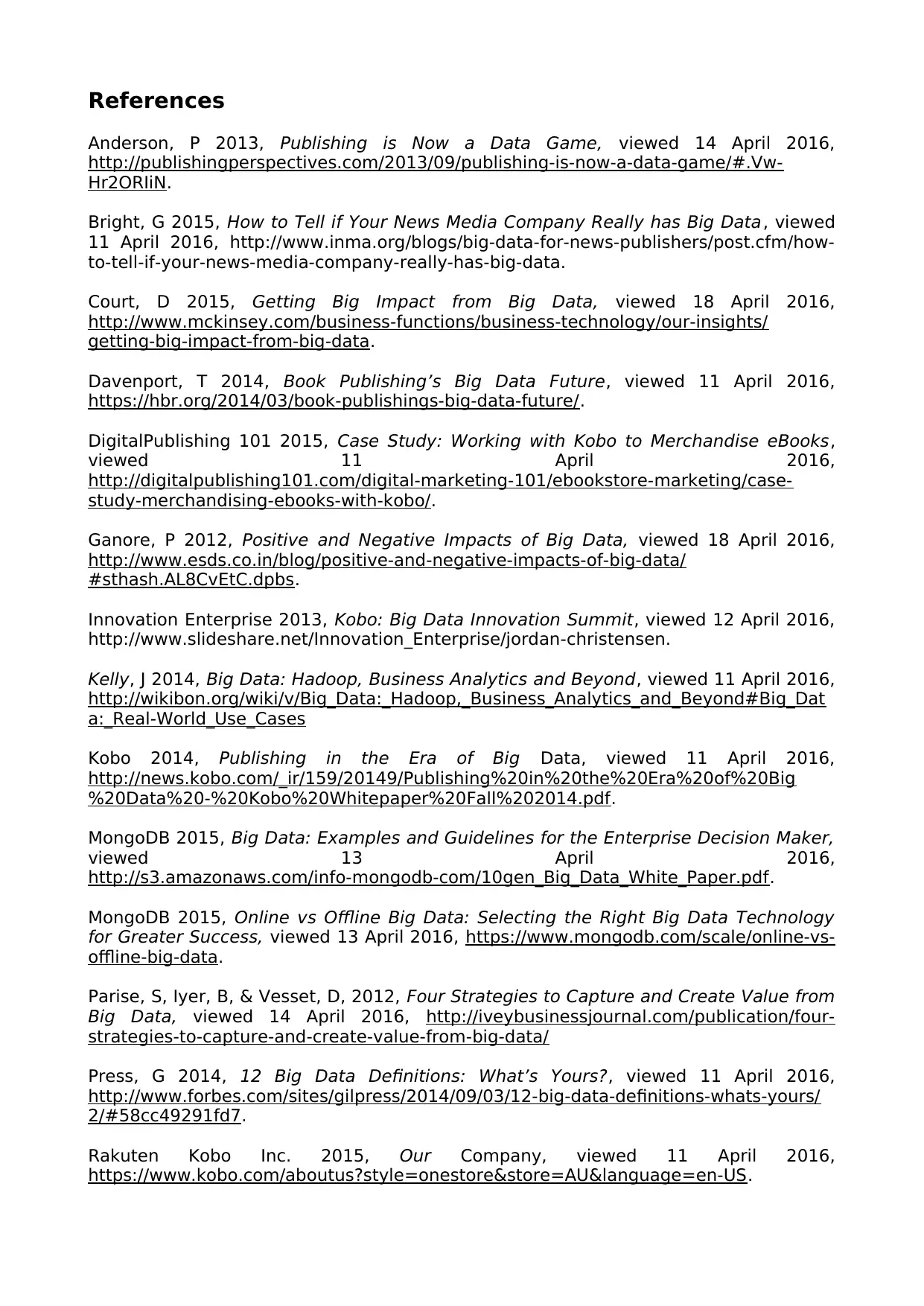
References
Anderson, P 2013, Publishing is Now a Data Game, viewed 14 April 2016,
http://publishingperspectives.com/2013/09/publishing-is-now-a-data-game/#.Vw-
Hr2ORIiN.
Bright, G 2015, How to Tell if Your News Media Company Really has Big Data, viewed
11 April 2016, http://www.inma.org/blogs/big-data-for-news-publishers/post.cfm/how-
to-tell-if-your-news-media-company-really-has-big-data.
Court, D 2015, Getting Big Impact from Big Data, viewed 18 April 2016,
http://www.mckinsey.com/business-functions/business-technology/our-insights/
getting-big-impact-from-big-data.
Davenport, T 2014, Book Publishing’s Big Data Future, viewed 11 April 2016,
https://hbr.org/2014/03/book-publishings-big-data-future/.
DigitalPublishing 101 2015, Case Study: Working with Kobo to Merchandise eBooks,
viewed 11 April 2016,
http://digitalpublishing101.com/digital-marketing-101/ebookstore-marketing/case-
study-merchandising-ebooks-with-kobo/.
Ganore, P 2012, Positive and Negative Impacts of Big Data, viewed 18 April 2016,
http://www.esds.co.in/blog/positive-and-negative-impacts-of-big-data/
#sthash.AL8CvEtC.dpbs.
Innovation Enterprise 2013, Kobo: Big Data Innovation Summit, viewed 12 April 2016,
http://www.slideshare.net/Innovation_Enterprise/jordan-christensen.
Kelly, J 2014, Big Data: Hadoop, Business Analytics and Beyond, viewed 11 April 2016,
http://wikibon.org/wiki/v/Big_Data:_Hadoop,_Business_Analytics_and_Beyond#Big_Dat
a:_Real-World_Use_Cases
Kobo 2014, Publishing in the Era of Big Data, viewed 11 April 2016,
http://news.kobo.com/_ir/159/20149/Publishing%20in%20the%20Era%20of%20Big
%20Data%20-%20Kobo%20Whitepaper%20Fall%202014.pdf.
MongoDB 2015, Big Data: Examples and Guidelines for the Enterprise Decision Maker,
viewed 13 April 2016,
http://s3.amazonaws.com/info-mongodb-com/10gen_Big_Data_White_Paper.pdf.
MongoDB 2015, Online vs Offline Big Data: Selecting the Right Big Data Technology
for Greater Success, viewed 13 April 2016, https://www.mongodb.com/scale/online-vs-
offline-big-data.
Parise, S, Iyer, B, & Vesset, D, 2012, Four Strategies to Capture and Create Value from
Big Data, viewed 14 April 2016, http://iveybusinessjournal.com/publication/four-
strategies-to-capture-and-create-value-from-big-data/
Press, G 2014, 12 Big Data Definitions: What’s Yours?, viewed 11 April 2016,
http://www.forbes.com/sites/gilpress/2014/09/03/12-big-data-definitions-whats-yours/
2/#58cc49291fd7.
Rakuten Kobo Inc. 2015, Our Company, viewed 11 April 2016,
https://www.kobo.com/aboutus?style=onestore&store=AU&language=en-US.
Anderson, P 2013, Publishing is Now a Data Game, viewed 14 April 2016,
http://publishingperspectives.com/2013/09/publishing-is-now-a-data-game/#.Vw-
Hr2ORIiN.
Bright, G 2015, How to Tell if Your News Media Company Really has Big Data, viewed
11 April 2016, http://www.inma.org/blogs/big-data-for-news-publishers/post.cfm/how-
to-tell-if-your-news-media-company-really-has-big-data.
Court, D 2015, Getting Big Impact from Big Data, viewed 18 April 2016,
http://www.mckinsey.com/business-functions/business-technology/our-insights/
getting-big-impact-from-big-data.
Davenport, T 2014, Book Publishing’s Big Data Future, viewed 11 April 2016,
https://hbr.org/2014/03/book-publishings-big-data-future/.
DigitalPublishing 101 2015, Case Study: Working with Kobo to Merchandise eBooks,
viewed 11 April 2016,
http://digitalpublishing101.com/digital-marketing-101/ebookstore-marketing/case-
study-merchandising-ebooks-with-kobo/.
Ganore, P 2012, Positive and Negative Impacts of Big Data, viewed 18 April 2016,
http://www.esds.co.in/blog/positive-and-negative-impacts-of-big-data/
#sthash.AL8CvEtC.dpbs.
Innovation Enterprise 2013, Kobo: Big Data Innovation Summit, viewed 12 April 2016,
http://www.slideshare.net/Innovation_Enterprise/jordan-christensen.
Kelly, J 2014, Big Data: Hadoop, Business Analytics and Beyond, viewed 11 April 2016,
http://wikibon.org/wiki/v/Big_Data:_Hadoop,_Business_Analytics_and_Beyond#Big_Dat
a:_Real-World_Use_Cases
Kobo 2014, Publishing in the Era of Big Data, viewed 11 April 2016,
http://news.kobo.com/_ir/159/20149/Publishing%20in%20the%20Era%20of%20Big
%20Data%20-%20Kobo%20Whitepaper%20Fall%202014.pdf.
MongoDB 2015, Big Data: Examples and Guidelines for the Enterprise Decision Maker,
viewed 13 April 2016,
http://s3.amazonaws.com/info-mongodb-com/10gen_Big_Data_White_Paper.pdf.
MongoDB 2015, Online vs Offline Big Data: Selecting the Right Big Data Technology
for Greater Success, viewed 13 April 2016, https://www.mongodb.com/scale/online-vs-
offline-big-data.
Parise, S, Iyer, B, & Vesset, D, 2012, Four Strategies to Capture and Create Value from
Big Data, viewed 14 April 2016, http://iveybusinessjournal.com/publication/four-
strategies-to-capture-and-create-value-from-big-data/
Press, G 2014, 12 Big Data Definitions: What’s Yours?, viewed 11 April 2016,
http://www.forbes.com/sites/gilpress/2014/09/03/12-big-data-definitions-whats-yours/
2/#58cc49291fd7.
Rakuten Kobo Inc. 2015, Our Company, viewed 11 April 2016,
https://www.kobo.com/aboutus?style=onestore&store=AU&language=en-US.
1 out of 11
Your All-in-One AI-Powered Toolkit for Academic Success.
+13062052269
info@desklib.com
Available 24*7 on WhatsApp / Email
![[object Object]](/_next/static/media/star-bottom.7253800d.svg)
Unlock your academic potential
Copyright © 2020–2025 A2Z Services. All Rights Reserved. Developed and managed by ZUCOL.